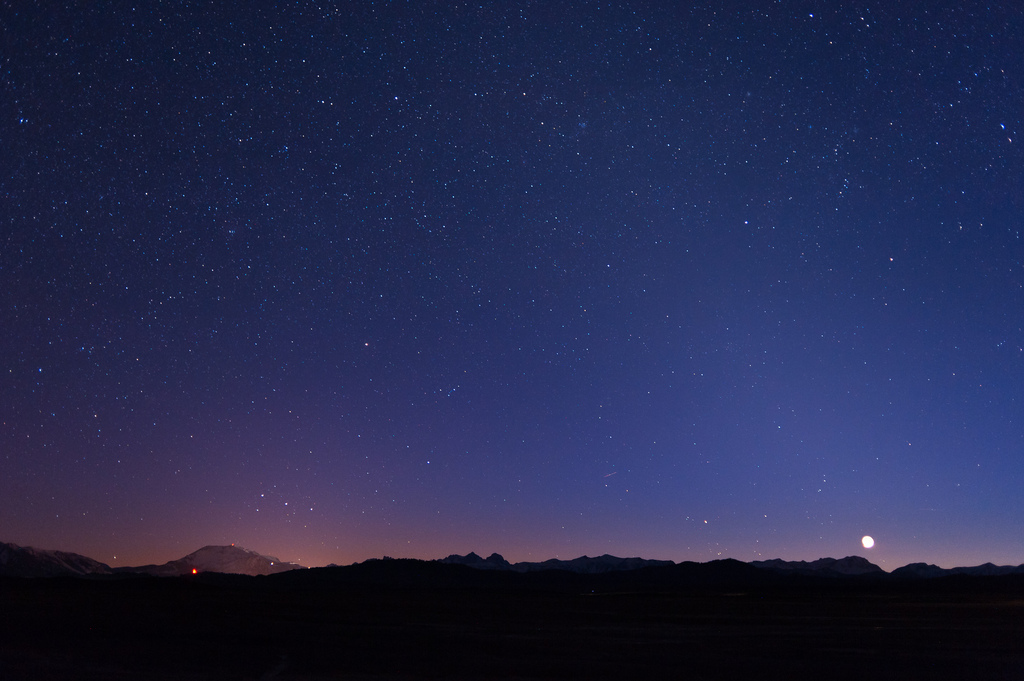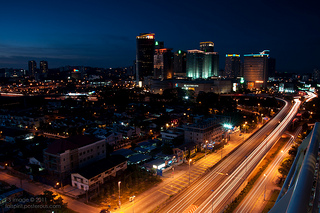
Image courtesy of John Lemieux © / Flickr (Creative Commons License)
As photographers we are always on the lookout for those moments in a day where the light is just right. We love the hours around sunrise and sunset. But when the sun does set we generally pack up and head home. After all, when the light is gone there’s nothing left to photograph right? Well today I’m going to explore some of the options available to us in the nocturnal hours. (I’m singing ‘After Midnight’ by J.J. Cale in my head. – hit play on the video at the bottom then you can hear what I’m hearing as you read the rest of my article.)
Night photography can be a really exhilarating experience. When you’re out there creating work while the rest of the world is at home on the couch or in bed, you get to see the world, and photography, from a totally different perspective, one that will open up entirely new possibilities for you.
Aside from the usual equipment, (camera, lens, memory card) you’ll also need a tripod. Really every photographer should have a tripod, but for the night photographer it’s an absolute must. The Vanguard Espod Plus for example, is a great entry-level tripod. One of the most common techniques employed when shooting landscapes or architecture after-hours is the long exposure, which obviously you can’t do hand-held. You’ll want to keep your ISO setting as low as possible in order to minimise the noise and this will make your exposure times even longer.
 Because of the scarcity of light, you need to expose the sensor for a number of seconds, or even minutes, in order to make a meaningful image. If you’re in or around the city, you’ll be relying on artificial light sources; street lights, headlights, and building lights for example. It can be interesting to try to find an elevated position with a stretch of road in view, as you get nice light trails from the passing cars.
Because of the scarcity of light, you need to expose the sensor for a number of seconds, or even minutes, in order to make a meaningful image. If you’re in or around the city, you’ll be relying on artificial light sources; street lights, headlights, and building lights for example. It can be interesting to try to find an elevated position with a stretch of road in view, as you get nice light trails from the passing cars.
Image courtesy of faispirit79 © / Flickr (Creative Commons License)
The rules of composition that make a good daytime image largely still apply at night. For example, using the ‘rule of thirds’ you’ll want to place points of interest on the imaginary lines that divide the frame in thirds. The ambience that the nighttime lends to your image is a further dimension that will add to the overall effect of good composition.
It is also possible to photograph natural landscapes at night, but this is a little more challenging, and not just because of the potential for twisting an ankle in a pothole! The light sources, the moon and stars, are much further away and hence their light is weaker, so making a meaningful image can be a little more hit-and-miss. On a cloudy night you may also find yourself using light pollution from city lights bouncing off clouds as a light source.
Obviously it’s going to be difficult to frame a good shot in total darkness so definitely try and do some scouting ahead of time, or at the very least, arrive before sunset so you can get yourself set up and also take a few test shots. Try and give your image a strong point of focus, an abandoned building or a tree, or even a rock. You’ll most likely include a horizon line too, so pay close attention to how much of the sky you want to include, depending on the conditions and the amount of visual interest exists in the foreground.
It’s likely that your exposure time will be a number of minutes in a remote location, so patience is truly a virtue for the night photographer. You’re going to be working in bulb mode, which means you press the shutter button, and keep it held down for the duration of the exposure. As soon as you remove your finger the aperture closes. This can get a bit tedious, and tiring for the old index finger, so one little piece of equipment you may want to invest in is a cable release. You plug it into the side of your camera and it gives you a more ergonomic way to activate the shutter. Some models will allow you to lock the button which means you don’t even have to hold the cable release itself. This in turn frees you up to take things to the next level with some light painting, which is where things get really interesting.
Light painting involves using a hand held light source to bring up the exposure on one element of your image. This might be the old building or tree mentioned earlier, but it could even be an entire cliff face. A flashlight is a must for light painting, and because you’re smart and always plan ahead you brought one to help you find your way back to the car. You can also experiment with using a hand-held flash unit to quickly and easily light up points of interest, although the effect of a flashlight is generally more interesting.
So the process would look like this; having framed your image while a little daylight existed, you press and lock the button on your cable release, and off you run (carefully!) to the point of interest you’ve identified and you shine your flashlight at it for a minute or so and then head back to your camera location and unlock the cable release button. The camera usually takes a while (relative to a normal daylight shot) to process the image, which kind of adds to the excitement.
 From there it’s all about experimentation. You’ll probably want to try moving the flashlight around your object, rather than keeping it stationary (hence the ‘painting’), or to light it from a number of different angles. You might also want to try lighting more than one object in the frame
From there it’s all about experimentation. You’ll probably want to try moving the flashlight around your object, rather than keeping it stationary (hence the ‘painting’), or to light it from a number of different angles. You might also want to try lighting more than one object in the frame
Don’t worry about the possibility of showing up in the image yourself. If you’re moving around and pointing the light source away from yourself, it’s really unlikely that you’ll show up. But if you want to create a spooky self-portrait, take a flash and hold it in front of your stomach and pop it once on your way back to the camera.
Once you get into light painting, you’ll realise the possibilities are endless. If you combine light painting with straight flash photography in a darkened studio, you can do some really interesting portraits and product shots, like this sushi shot I did a few years back. You can also try writing and drawing with little LED lights or sparklers. As I said, the possibilities are endless.



